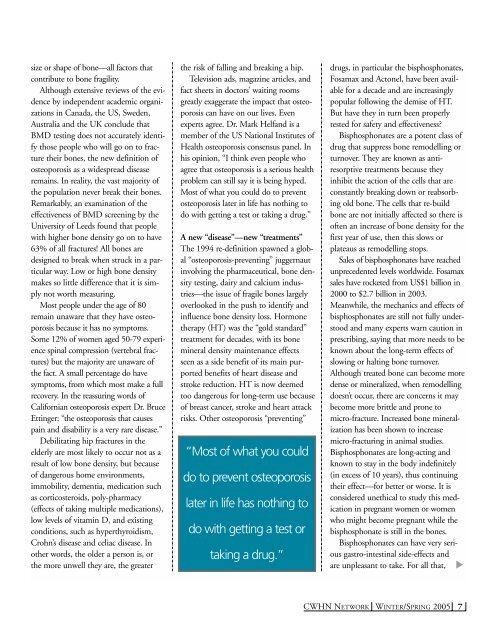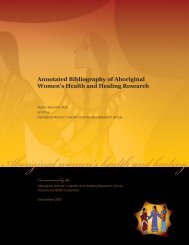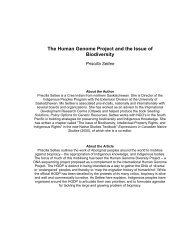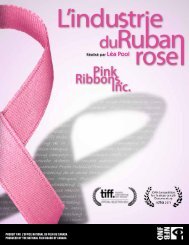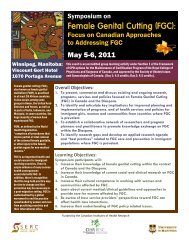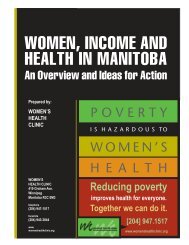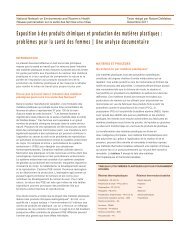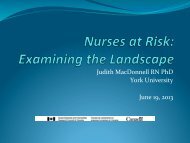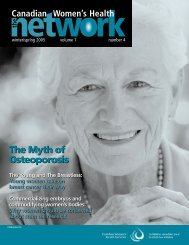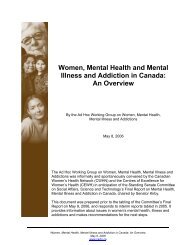NETWORK WIN00 - Canadian Women's Health Network
NETWORK WIN00 - Canadian Women's Health Network
NETWORK WIN00 - Canadian Women's Health Network
You also want an ePaper? Increase the reach of your titles
YUMPU automatically turns print PDFs into web optimized ePapers that Google loves.
size or shape of bone—all factors that<br />
contribute to bone fragility.<br />
Although extensive reviews of the evidence<br />
by independent academic organizations<br />
in Canada, the US, Sweden,<br />
Australia and the UK conclude that<br />
BMD testing does not accurately identify<br />
those people who will go on to fracture<br />
their bones, the new definition of<br />
osteoporosis as a widespread disease<br />
remains. In reality, the vast majority of<br />
the population never break their bones.<br />
Remarkably, an examination of the<br />
effectiveness of BMD screening by the<br />
University of Leeds found that people<br />
with higher bone density go on to have<br />
63% of all fractures! All bones are<br />
designed to break when struck in a particular<br />
way. Low or high bone density<br />
makes so little difference that it is simply<br />
not worth measuring.<br />
Most people under the age of 80<br />
remain unaware that they have osteoporosis<br />
because it has no symptoms.<br />
Some 12% of women aged 50-79 experience<br />
spinal compression (vertebral fractures)<br />
but the majority are unaware of<br />
the fact. A small percentage do have<br />
symptoms, from which most make a full<br />
recovery. In the reassuring words of<br />
Californian osteoporosis expert Dr. Bruce<br />
Ettinger: “the osteoporosis that causes<br />
pain and disability is a very rare disease.”<br />
Debilitating hip fractures in the<br />
elderly are most likely to occur not as a<br />
result of low bone density, but because<br />
of dangerous home environments,<br />
immobility, dementia, medication such<br />
as corticosteroids, poly-pharmacy<br />
(effects of taking multiple medications),<br />
low levels of vitamin D, and existing<br />
conditions, such as hyperthyroidism,<br />
Crohn’s disease and celiac disease. In<br />
other words, the older a person is, or<br />
the more unwell they are, the greater<br />
the risk of falling and breaking a hip.<br />
Television ads, magazine articles, and<br />
fact sheets in doctors’ waiting rooms<br />
greatly exaggerate the impact that osteoporosis<br />
can have on our lives. Even<br />
experts agree. Dr. Mark Helfand is a<br />
member of the US National Institutes of<br />
<strong>Health</strong> osteoporosis consensus panel. In<br />
his opinion, “I think even people who<br />
agree that osteoporosis is a serious health<br />
problem can still say it is being hyped.<br />
Most of what you could do to prevent<br />
osteoporosis later in life has nothing to<br />
do with getting a test or taking a drug.”<br />
A new “disease”—new “treatments”<br />
The 1994 re-definition spawned a global<br />
“osteoporosis-preventing” juggernaut<br />
involving the pharmaceutical, bone density<br />
testing, dairy and calcium industries—the<br />
issue of fragile bones largely<br />
overlooked in the push to identify and<br />
influence bone density loss. Hormone<br />
therapy (HT) was the “gold standard”<br />
treatment for decades, with its bone<br />
mineral density maintenance effects<br />
seen as a side benefit of its main purported<br />
benefits of heart disease and<br />
stroke reduction. HT is now deemed<br />
too dangerous for long-term use because<br />
of breast cancer, stroke and heart attack<br />
risks. Other osteoporosis “preventing”<br />
“Most of what you could<br />
do to prevent osteoporosis<br />
later in life has nothing to<br />
do with getting a test or<br />
taking a drug.”<br />
drugs, in particular the bisphosphonates,<br />
Fosamax and Actonel, have been available<br />
for a decade and are increasingly<br />
popular following the demise of HT.<br />
But have they in turn been properly<br />
tested for safety and effectiveness?<br />
Bisphosphonates are a potent class of<br />
drug that suppress bone remodelling or<br />
turnover. They are known as antiresorptive<br />
treatments because they<br />
inhibit the action of the cells that are<br />
constantly breaking down or reabsorbing<br />
old bone. The cells that re-build<br />
bone are not initially affected so there is<br />
often an increase of bone density for the<br />
first year of use, then this slows or<br />
plateaus as remodelling stops.<br />
Sales of bisphosphonates have reached<br />
unprecedented levels worldwide. Fosamax<br />
sales have rocketed from US$1 billion in<br />
2000 to $2.7 billion in 2003.<br />
Meanwhile, the mechanics and effects of<br />
bisphosphonates are still not fully understood<br />
and many experts warn caution in<br />
prescribing, saying that more needs to be<br />
known about the long-term effects of<br />
slowing or halting bone turnover.<br />
Although treated bone can become more<br />
dense or mineralized, when remodelling<br />
doesn’t occur, there are concerns it may<br />
become more brittle and prone to<br />
micro-fracture. Increased bone mineralization<br />
has been shown to increase<br />
micro-fracturing in animal studies.<br />
Bisphosphonates are long-acting and<br />
known to stay in the body indefinitely<br />
(in excess of 10 years), thus continuing<br />
their effect—for better or worse. It is<br />
considered unethical to study this medication<br />
in pregnant women or women<br />
who might become pregnant while the<br />
bisphosphonate is still in the bones.<br />
Bisphosphonates can have very serious<br />
gastro-intestinal side-effects and<br />
are unpleasant to take. For all that,<br />
▲<br />
CWHN <strong>NETWORK</strong> WINTER/SPRING 2005 7


